► Peek behind closed doors at Koenigsegg
► The incurably extreme supercar upstart
► Originally published in CAR magazine, Aug ’16
This, then, is it: the end of the line. Increase power, refuse to let weight or bulk take hold and pay for the exercise with a list price so extreme that both exclusivity and absolute technical freedom are guaranteed and you find yourself not in Modena, Munich or Molsheim but here, in Ängelholm, Sweden, in the curious realm of Koenigsegg. Here, Christian von Koenigsegg’s team creates machines of unholy performance, and it does so with an almost masochistic aversion to doing anything the easy way.
The path of least resistance is nowhere to be seen in the Regera, its fiendishly complex hypercar (three electric motors, no gearbox, twin-turbo V8, F1-spec battery). ‘It’s more than 500kg lighter than a Tesla Model S but with a V8 roar and another 1000bhp!’ beams Koenigsegg. And it was nowhere to be seen 21 years ago when he decided import/export wasn’t floating his boat and he was going to build supercar. ‘I asked myself why anyone would buy a Swedish supercar when they could buy a Ferrari or a Lamborghini,’ says Koenigsegg. ‘Our cars had to be lighter, more nimble, more powerful. Sure, those guys were trying but maybe they weren’t trying hard enough.’
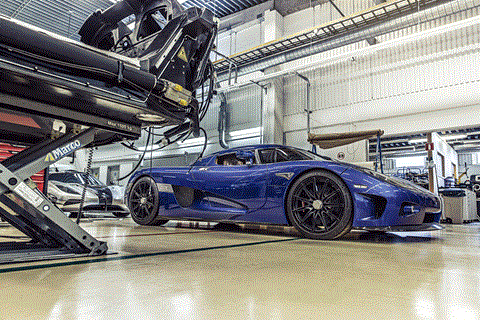
Koenigsegg’s always trying hard. When CAR visits it’s a Swedish national holiday but still the place is at work: still the CAD stations hum, rendering engineering of baffling complexity; still the boss is in. No aloof figurehead, Christian von Koenigsegg’s job description is broad to say the least: creative force, motive engine, public face, customer liason. That last point is important to the people who buy cars of this ilk, people for whom customer service isn’t a complimentary cappuccino. At this level – the level at which Luca di Montezemolo shows up in your selfies – it’s about being on first name terms with the man who carried your car’s blueprints around in his head as a schoolboy.
For the first time in its relatively brief history, Koenigsegg is a carmaker with a model range: the relatively refined hybrid Regera, now in the final phase of its development, and the Agera RS, ultimate iteration of the company’s long-serving Agera platform, developed with lessons learned crafting the limited edition One:1 (1341bhp, 1360kg, hand-ported heads, 0-250-0mph in 30 seconds). The One:1’s sold out. The Regera’s not ready for press drives. But thanks to the generosity of its owner, Michael Loke, an Agera RS is.

An array of linkages and pivots takes the featherlight door from closed to open and held perfectly vertical in a single, silky movement. The sill is vast, glossy and oddly comforting in conspicuously stout carbon. The cabin is like nothing else I’ve sat in, the wraparound but heavily tapered screen giving both great visibility and the sensation of being sat in a tank.
Even at idle the engine’s a rich, complex and bass-heavy slab of intimidation. The three-stage traction control is set to full coward. Loke’s nervous
smile suggests I leave it there.
Clunking into first gear, I ease the throttle forward with what I hope is something like the right blend of determination and grace. There follows, in very short order, rhythmic smudges of wheelspin and retarded power, a great storm of mildly terrifying noise and, as the tyres finally achieve clean traction, giddying acceleration with very little squat. Tug the shifter, pause as the slightly unrefined but satisfying CIMA gearbox does its thing (it’s not a twin-clutch unit – Koenigsegg doesn’t like them), feel the world behind you lapse into violent freefall.
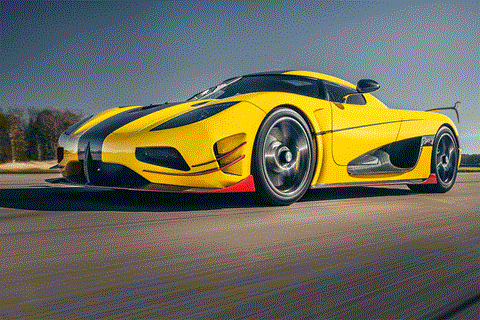
At 160mph, in someone else’s £1,240,000 car, I try a few direction changes. They’re instantaneous, roll-free and easy, like a videogame. This is no civilised Veyron, more a Lotus charged with brutal Bugatti-esque thump. Get into the power again, laugh at the almost lag-less response and ponder trying to hustle this thing on a circuit. Laugh harder. With active aero elements there’s genuine go-faster-to-go-faster downforce here (450kg at 160mph) of an order of magnitude even mortals can feel.
Around Silverstone I’d be a sweat-soaked sack of a man inside three laps. The Agera RS doesn’t do very significant speeds the disservice of feeling easy. It’s a physical car, one that renders cause and effect with intoxicating clarity. I’ve never driven a Group C racer but pop the rear clamshell and the Agera RS looks and smells like one. Find the space to set it free and it feels like one: think-and-you’re-there fast, roll-your-wrists agile and alive with mechanical fury.
Loke’s beaming like a proud father as I clamber from the car. I mumble something about it being like a Lotus Veyron. He nods at my nonsense and tells me about how the car came to be his, about how he visited Pagani and pondered a McLaren P1 but decided they weren’t quite right for a stable that’s included Ferraris (458 Speciale, 599), Lamborghinis (Aventador, Gallardo Superleggera) and a nice dollop of British luxury (Rolls Ghost, Bentley Flying Spur).
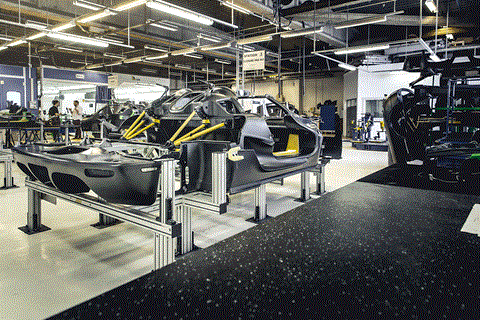
Back at the factory, within earshot of the runway on which we can hear Loke perfecting his just-so standing starts, Christian von Koenigsegg’s in talks with Jon Gunner. Gunner’s business card trumps most I’ve seen – ‘Technical director, hypercar and high performance vehicle development’. Generously they pause their conversation to give me the guided tour.
To reach the workshops you enter reception and pass through a clean, bright hive of glass-walled offices. A covered tunnel leads on to the assembly areas, housed in a former hanger. In a service bay one-third of all the One:1s ever built – two of the six – await attention. In the main assembly area carbon tubs move between stations gaining exquisite componentry: engine and seven-speed gearbox, suspension, wiring, interior. Koenigsegg will build 16 cars this year. The waiting list is three years.
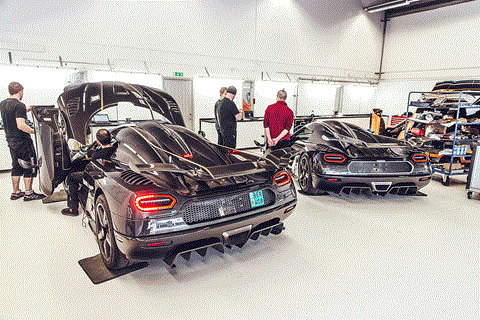
The main chassis structure is a work of art, its sections bonded together in long seams of adhesive capable of seeing off forces in excess of 2500 tonnes per square inch. The essential structure is symmetrical, to be easily built up in (or switched between) left- or right-hand drive. ‘The tub is my baby,’ explains Gunner. ‘The structure was derived from what Koenigsegg had been doing with the CCR. ‘I came in after the CCR, and tried to take all that was good about that design and productionise it. When I first met Christian, I was working at Saab aerospace. Then when the 2005 Ford GT programme wrapped up, on which I was responsible for the body, chassis and systems, I was looking for another project. We’re a small team for such an engineering-intensive company; about 28 engineers.’
In all directions different departments head off into corners of the Koenigsegg complex; engine shop, composites, prototyping. I expected noise, the fug of glassfibre and quite a lot of mess. I find well-lit calm set to soft Swedish pop. Each car takes six months to build. Almost all of it, from the loom through the body panels, chassis, engine, wheels and brakes are made in-house, on-site. The only limitation is the size of the firm’s autoclave and the fact that some of the cars’ biggest composite parts simply don’t fit in it. Expertly wrought carbon is essential to the Koenigsegg way. More than 400 carbon parts, from intake plenums and cam covers (to lower the engine’s centre of gravity) to bodywork and seats, go into each car.
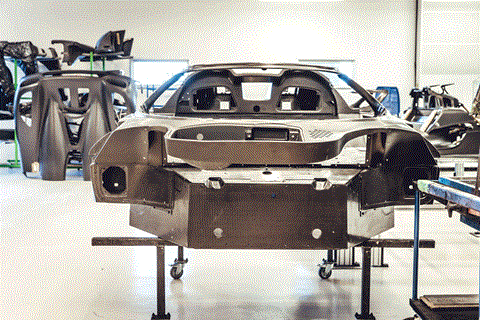
‘The first prototype had a steel monocoque with a honeycomb composite floor and a carbon body,’ says Koenigsegg. ‘A composites engineer read about us and dropped me a line to say he was designing carbon tubs at the Newman/Haas race team and did I have any work for him? Well yes, maybe! He stayed two years. When he joined we were making simple parts in carbon – he helped us take it to the next level. We became experts.’
On cue I find myself grasping a wheel. Its weight fails to correlate in any way to its size. The 19-inch front chimes in at just 5.5kg; the 20-inch rear 6.5kg. The finish is exquisite. The glossy black stuff’s a perfect fit for Koenigsegg: incredible performance at horrific cost, in both time and money. At their thinnest the wheels comprise just three layers of pre-preg carbon cloth. Where loads are high, such as where the spokes meet the hub, there are 25 layers, oriented with the predicted load paths. Each wheel uses no fewer than 650 individual carbon elements. A set of four takes a month to make.

Next door, Mats Pettersson the engine builder assembles V8s at a similar rate, and with equally impressive patience. ‘The aluminium blocks are precision cast in the UK,’ explains Pettersson. ‘CP-Carrillo in the US make the pistons to our design; they’re a slipper-type, light at 270g and with a short skirt. Another American company – I can’t tell you who – produces the crankshafts. This is a Regera engine, with a crankshaft design to suit the application: much stiffer, to deal with the extreme torque of the electric motors, yet almost 6kg lighter than the Agera crank.
‘When we did the One:1 engine I hand-ported the heads – 50 hours per engine, with a rotary hand tool. [The Agera RS and One:1 engines are closely related. Together with Pettersson’s painstaking handiwork different camshafts, with more duration and lift, account for the One:1’s power advantage]. When I started here Koenigsegg had been told there was no advantage in porting turbocharged engines. In my first weeks I was able to tell them that was crap. Now my porting is done by computer. We can’t build every production engine with hand-ported heads – I’m the only guy building the engines! It’s the required precision that takes the time. These engines may have over 1000bhp but each unit’s peak output varies by less than 5bhp. But you do have to be special to work here – it’s not an ordinary 9-5 job!’

It’s a familiar Koenigsegg refrain and nowhere more so than in the prototype workshops, where guys in black shorts and shirts fuss around the first two Regeras like ants on a dropped Sherbert Dip Dab.
The Regera is Koenigsegg’s hybrid hypercar, unveiled at the 2015 Geneva show. Just 80 will be built, and your £1,470,000 buys a unique powertrain melding Koenigsegg’s trademark twin-turbo V8 with a liquid-cooled 4.5kWh battery and three electric motors for a combined 1479bhp. With no gearbox 4
the two power sources work in concert, the motors’ instant drive filling in the blanks when the turbo V8 – which is effectively locked in top gear, on a 2.73 final drive ratio – can’t and, conversely, the V8 raging in the thick of its powerband when, at silly speeds, electric drive starts to struggle.
‘I subscribe to Colin Chapman’s way of thinking, and gearboxes have always annoyed me for that reason,’ explains Koenigsegg. ‘You’re only using one pair of gears at a time – the rest is just heavy metal ballast at the back of the car. So I was thinking about how we could use the same space, weight and complexity to give benefit all the time. I looked at CVTs but they’re horrible, with this rubber-band disconnect. Then the right cell, electric motor and inverter technology came along. We could maintain our DNA but remove the gears and add excitement, functionality and efficiency without doing the normal hybrid stuff, which tends to be clumsy and heavy. We have reduced drivetrain losses by removing the gearbox, and at the same time we have 1100lb ft of torque available from a standstill.’
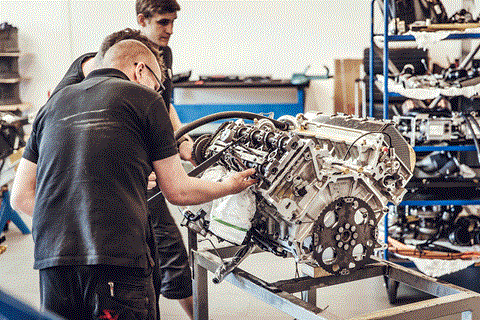
The Regera is a result of Jon Gunner not saying no to Christian quite as quickly or emphatically as he needed to. ‘Christian has a thousand ideas a day,’ smiles Gunner. ‘I’m his filter, and if I say yes to something I’m late if it’s not on the car an hour later. That said, speed is one of our key strengths. We’re very dynamic in the way that we conduct our research and development work. Unlike a lot of automotive companies, who define a fixed specification and then work to deliver it, we see specification as a fluid thing. We’re pushing the limits the whole time, which is stimulating but challenging. We were more or less done with Regera development by October 2014, a few months ahead of its Geneva show unveiling, when it was suggested it should have a completely new powertrain, suspension and rear end. Up until then it was set to have a conventional gearbox…’
On the shop floor, wrestling with the installation of this frighteningly complex powertrain is Mattias Vöx, the Koenigsegg engineer who sprung to internet notoriety when the much-modified 200mph 1967 Volvo Amazon he built was bought by motorcycle racer and furry TV face Guy Martin.
‘We’re the link between the designers and reality,’ says Vöx . ‘We figure out the problems and make things happen. It’s not so easy to consider the realities when you’re sitting behind a computer screen. For that you need an engineering brain but also a mechanical mind. I was a truck mechanic until I was 21, when I joined here, and I’ve been restoring classic cars since I was 18. When I started we were very small, 14 people in total. The Regera demanded a dedicated prototype department, and now we are 125 I think.
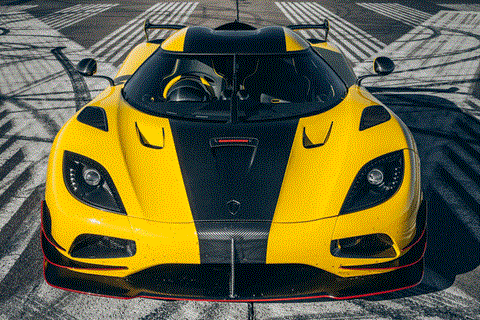
‘It’s very satisfying, solving all the issues in a high-performance, Koenigsegg way. [Croatian EV maker] Rimac worked with us on the high-voltage installation, helping us understand what works and what’s dangerous. But we’ve done a lot of work on the system too. Take the original power distribution unit. Rimac-style it was a big aluminium box weighing 40kg. Now, Koenigsegg-style, it’s down to 12kg and the size of a normal car battery. Cooling was the other challenge: cooling demand is up 40% over the Agera. We have additional radiators in the front for battery cooling, with an ultra-efficient electric circulation pump for a smaller radiator, and at the back we have cooling for the inverter and the electric motors – a big fan that sucks the shit out of them.’
The Regera’s drivetrain has dominated coverage of the car, and rightly so – even as hybrid hypercars become the norm, no one’s doing things quite like Koenigsegg. But more than the car’s incomprehensible performance figures it’s the Regera’s restrained and sophisticated design, inside and out, that really impresses. Where previously Koenigseggs have majored on an appealingly brutal, racecar aesthetic, the Regera is genuinely beautiful, complete with artful ‘constellation’ headlights. Pop open the doors (as you can, together with the front and rear clamshells, with a single button-press) and the leap over the Agera is more like three generations than one. This is a sophisticated machine of leading-edge tech and quite exquisite detailing.
That the Regera will be extraordinary is a given – Koenigsegg’s raw numbers have always been spectacularly Top Trumps. What’s really exciting is how successfully this little firm has translated its essential DNA into a different kind of hypercar, an altogether more complex, nuanced and refined machine that proves there’s more to Ängelholm than brute force and carbon. Way out there, in a place where 1479bhp plug-in hybrids with titanium fishtail silencers make perfect sense, the kingdom that Christian built feels like it’s just getting started.
Photography by Mark Riccioni
Watch the Koenigsegg Agera RS hit 284mph